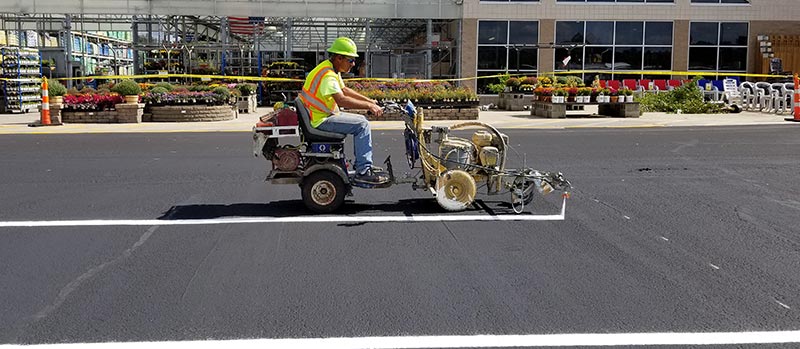The Ultimate Guide To A1 Professional Asphalt & Sealing Llc
Table of ContentsGetting My A1 Professional Asphalt & Sealing Llc To WorkThe Ultimate Guide To A1 Professional Asphalt & Sealing Llc8 Easy Facts About A1 Professional Asphalt & Sealing Llc DescribedIndicators on A1 Professional Asphalt & Sealing Llc You Need To KnowA1 Professional Asphalt & Sealing Llc for Dummies

The oil in an automobile engine is not simply oil. It has a range of ingredients to enhance the lorry's performance. These consist of polymers, viscosity modifiers, warm stabilizers, extra lubricants, and put on ingredients. The REOB includes all the additives that remained in the waste oil in addition to the wear metals from the engine (mostly iron and copper).
Nonetheless, by making lots of blends using various REOB samples and different asphalt binders, the variants largely can be averaged out. A number of States provided examples of well-known REOB make-up to TFHRC scientists, that analyzed the examples to compare the percentage of included (known) REOB to the found (checked) amount. The evaluations revealed a similar percent of included and found REOB.
The 25-Second Trick For A1 Professional Asphalt & Sealing Llc
None of those States recognized that the asphalt they were buying consisted of REOB. One State insisted its samples had no REOB - https://gravatar.com/a1asphaltsealng.
Of the 1,532 samples tested, 12 percent consisted of REOB, and some had considerably high degrees of it at 1020 percent. The highest degree was 34 percent in a sample from Texas, which TxDOT had actually utilized in a patching compound. This testing also disclosed the presence of phosphoric acid in 11 percent of the samples, and 2 percent contained ground tire rubber.
Two years earlier at TRB's yearly conference, the Federal scientists held an REOB workshop and provided the searchings for of their lab evaluations to a standing room-only group. Although some firms do not especially outlaw REOB, they do impose physical examinations that avert its useeffectively a ban. a1 professional. Others do not outlaw it by requirements, yet have agreements with asphalt providers to stay clear of the usage of REOB
The smart Trick of A1 Professional Asphalt & Sealing Llc That Nobody is Discussing
A handful do allow REOB, some within particular limits. As an example, Ohio and Texas restriction degrees to less than 5 percent of the asphalt. To develop a reliable examination method that all States can utilize, the TFHRC scientists established a round-robin examination strategy. The participants are 11 State freeway firms (Illinois, Massachusetts, Minnesota, Mississippi, Montana, North Carolina, Oklahoma, South Carolina, Texas, Vermont, and Wyoming), 2 independent screening labs, the Ministry of Transport in Ontario, Queen's College in Ontario, and an Ontario paving service provider.
In total, the researchers prepared and shipped 720 blends. The participants are checking the samples separately using the guidelines offered by the TFHRC researchers. The round-robin testing is virtually completed, and TFHRC is in the process of gathering the results. The outcome will be a proposed AASHTO examination method that any State can embrace and use (what is cold asphalt?).
The sidewalk with REOB, which is located 0.6 mile (1 kilometer) from the pavement without REOB, has similar subgrade, web traffic density, and environment. Nonetheless, the section of Highway655 with 5 to 10 percent REOB revealed considerable cracking. In this example, the visibility of REOB was the identified root cause of breaking at a reduced temperature levels.
An area of examination sidewalk in Minnesota (MN1-4) discovered to have REOB additionally cracked prematurely. The sidewalk executed well for the very first 3 to 4 years, however then began to split.
The smart Trick of A1 Professional Asphalt & Sealing Llc That Nobody is Talking About
The tests were not considerable, but they revealed that at levels of 6 percent or more, the tensile stamina of the asphalt went down considerably. At a degree of 3.5 percent REOB, the variant in the physical examination methods was better than the result of REOB. As a matter of fact, it was tough for scientists to examine whether REOB existed.

One binder specification taken into consideration is the difference between the reduced temperature critical requirements temperature for tightness (S) in the flexing light beam rheometer and the bending light beam rheometer creep slope (m-value) kept in mind as Tcritical. TC = TC (S) TC (m-value). Assessment Resources of this parameter is still continuous. 2 independent research groups, one from AASHTO and the various other from the Asphalt Institute, concluded that even more research study is required on the usage of REOB in asphalt.
Formerly, all asphalt testing measured design homes such as rigidity. These examinations do disappoint what materials had been included in the asphalt. One sample gotten during the TFHRC study had a very weird analysis. The example had the adhering to test outcomes: Superpave PG 64-28 with a heat grade of 67.3 Tcritical on the bending beam rheometer was 6.7 levels Celsius.

The Greatest Guide To A1 Professional Asphalt & Sealing Llc
These results demonstrate there are weaknesses in the standardized design screening procedures that might be exploited. The producer may have a financial benefit and the item passes all the standardized examinations, yet the item may not be useful to ensuring long-lasting performance. To address this issue and the development of new asphalt ingredients and extenders, TFHRC is starting a study program to make use of portable spectroscopic gadgets, x-ray fluorescence spectroscopy, and Fourier transform infrared spectroscopy to make it possible for evaluations to be carried out in the field instead of needing to take samples back to the lab.